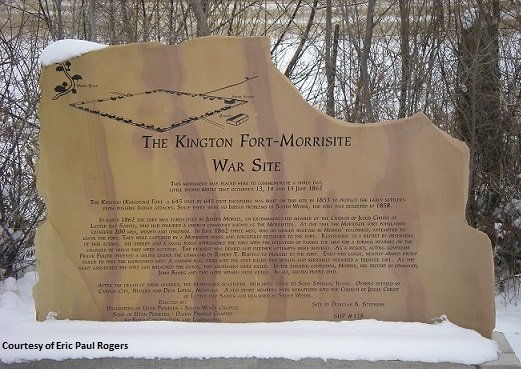Dublin Core
Title
Description
Eight members of a Mormon fringe group were killed by militiamen in south Weber County.
In 1858, Mormon immigrant Joseph Morris sent a letter to LDS Church president Brigham Young naming himself as the church’s true leader. A convert to Mormonism from Cheshire, England, Morris came to Utah soon after the Great Basin had been colonized. He settled first in Salt Lake, then moved to Ephraim, Provo, and American Fork. By the 1850s, he had begun criticizing Mormon practices, including plural marriage, and running into problems with local church authorities.
Perhaps hoping to escape what he felt was ecclesiastical abuse, Morris moved to Weber County, where he began to attract a following. But his problems seemed to pursue him north, and eventually he was excommunicated from the LDS Church along with his new congregation. His preaching, though, was powerful and within a few years he had attracted close to a thousand followers of which half had been baptized into his new church.
But a lot of local Mormons were offended by the presence of the Morrisites in Weber County. Memory of anti-Mormon persecution in the Midwest led leaders and members of the LDS Church in Utah to adopt a bunker mentality and lash out at opposition from critics from within and without. It wasn’t until Morris detained a number of his own followers, disillusioned by the fact that some of his prophecies were never fulfilled, that local authorities stepped in and ordered Morris to free the prisoners.
When he refused, five companies of militia under the command of Robert Burton marched to South Weber where Morris and his church had put down roots. Eventually a firefight broke out killing a number of Morrisites including Morris himself. The prophet’s body was carted back to Salt Lake where it was put on public display and then quietly buried.
Creator
Source
Image: Photo of a monument commemorating the Morrisite War. The monument is located at the northeast intersection of S 475 E and E 6650 S in South Weber, Utah. December 2008. Courtesy of Eric Paul Rogers on Wikicommons.
_______________
See G. M. Howard, “Men, Motives, and Misunderstandings: A New Look at the Morrisite War of 1862,” Utah Historical Quarterly 44 (1976): 112-132; David L. Bigler, Forgotten Kingdom: The Mormon Theocracy in the American West, 1847-1896 (Logan: Utah State University Press, 1998), 208-217; and Kenneth Godfrey’s entry on the Morrisites in the online Utah History Encyclopedia.

